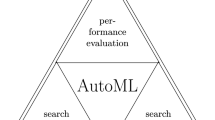Abstract
We describe a novel extension of the Poisson regression model to be based on a multi-layer perceptron, a type of neural network. This relaxes the assumptions of the traditional Poisson regression model, while including it as a special case. In this paper, we describe neural network regression models with six different schemes and compare their performances in three simulated data sets, namely one linear and two nonlinear cases. From the simulation study it is found that the Poisson regression models work well when the linearity assumption is correct, but the neural network models can largely improve the prediction in nonlinear situations.

Similar content being viewed by others
References
McCulloch W, Pitts W (1943) A logical calculus of ideas immanent in nervous activity. Bull Math Biophys 5:115–133. doi:10.1007/BF02478259
Ripley BD (1996) Pattern recognition and neural networks. Cambridge University Press, London
Bishop CM (2006) Pattern recognition and machine learning. Springer, New York
Ripley RM, Harris AL, Tarassenko L (2004) Non-linear survival analysis using neural networks. Stat Med 23:825–842. doi:10.1002/sim.1655
Faraggi D, Simon R (1995) The maximum likelihood neural network as a statistical classification model. J Statist Plann Inference 46:93–104. doi:10.1016/0378-3758(95)99068-2
Mathieson MJ (1996) Ordinal models for neural networks. Neural networks in financial engineering. In: Refences A-PN, Abu-Mostafa Y, Moody J, Weigend A (eds), Proceedings of the third international conference on neural networks in the capital markets, pp 23–536
Nejadgholi I, Seyyedsalehi SA (2009) Nonlinear normalization of input patterns to speaker variability in speech recognition neural networks. Neural Comput Appl 18:45–55. doi:10.1007/s00521-007-0151-5
Baxt WG (1990) Use of an artificial neural network for data analysis in clinical decision-making: the diagnosis of acute coronary occlusion. Neural Comput 2:480–489. doi:10.1162/neco.1990.2.4.480
Huang YL, Wang KL, Chen DR (2006) Diagnosis of breast tumors with ultrasonic texture analysis using support vector machines. Neural Comput Appl 15:164–169. doi:10.1007/s00521-005-0019-5
Akin M, Kurt MB, Sezgin N, Bayram M (2008) Estimating vigilance level by using EEG and EMG signals. Neural Comput Appl 17:227–236. doi:10.1007/s00521-007-0117-7
Bailey TC, Everson RM, Fieldsend JF, Krzanowski WJ, Partridge D, Schetinin V (2007) Representing classifier confidence in the safety critical domain: an illustration from mortality prediction in trauma cases. Neural Comput Appl 16:1–10. doi:10.1007/s00521-006-0053-y
Eftekhar B, Mohammad K, Eftekhar H, Ghodsi M, Ketabchi E (2005) Comparison of artificial neural network and logistic regression models for prediction of mortality in head trauma based on initial clinical data. BMC Med Inform Decis Mak 5:3. doi:10.1186/1472-6947-5-3
Sadat-Hashemi SM, Kazemnejad A, Lucas C, Badie K (2005) Predicting the type of pregnancy using artificial neural networks and multinomial logistic regression: a comparison study. Neural Comput Appl 14:198–202. doi:10.1007/s00521-004-0454-8
Leondes CT (1998) Neural network systems techniques and applications. Academic Press, San Diego
Shafi I, Ahmad J, Shah SI, Kashif FM (2008) Computing de-blurred time frequency distributions using artificial neural networks. Circuits Syst Signal Process 27:277–294. doi:10.1007/s00034-008-9027-x
Shafi I, Ahmad J, Shah SI, Kashif FM (2007) Evolutionary time-frequency distributions using Bayesian regularised neural network model. IET Signal Process 1:97–106. doi:10.1049/iet-spr:20060311
Funahashi K (1989) On the approximate realization of continuous mapping by neural networks. Neural Netw 2:183–192. doi:10.1016/0893-6080(89)90003-8
Hornik K, Stinchcombe M, White H (1989) Multilayer feedforward networks are universal approximators. Neural Netw 2:359–366. doi:10.1016/0893-6080(89)90020-8
Pearlmutter BA (1994) Fast exact multiplication by the Hessian. Neural Comput 6:147–160. doi:10.1162/neco.1994.6.1.147
Nabney I (2001) Netlab algorithms for pattern recognition. Springer London Ltd, UK
Acknowledgments
This study was sponsored by Tehran University of Medical Sciences. Most of this work was carried out during a sabbatical year (student visitor period) of Nader Fallah at the Department of Mathematics and Statistics in Dalhousie University. Authors wish to thank R. Ripley and I. Nabney for their help on R and Matlab Codes. The authors thank Catherine Pretty and Janet Brush for editing this manuscript.
Author information
Authors and Affiliations
Corresponding author
Rights and permissions
About this article
Cite this article
Fallah, N., Gu, H., Mohammad, K. et al. Nonlinear Poisson regression using neural networks: a simulation study. Neural Comput & Applic 18, 939–943 (2009). https://doi.org/10.1007/s00521-009-0277-8
Received:
Accepted:
Published:
Issue Date:
DOI: https://doi.org/10.1007/s00521-009-0277-8




